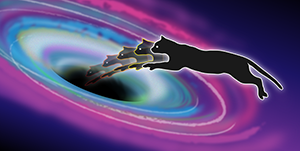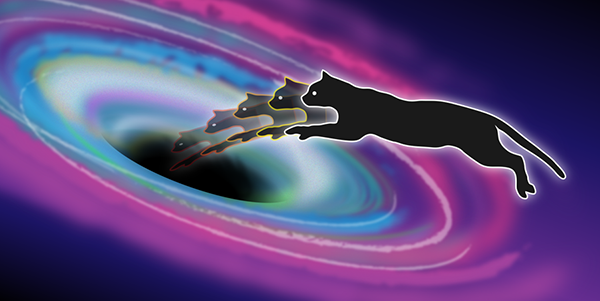What’s Inside a Black Hole’s Horizon?
New York City mayoral candidate Joe Lhota generated a public outcry when he indicated that he would not have shut down subway service for a pair of kittens lost in the tunnels. Even more outrage could have arisen from the discussions that took place at the Kavli Institute for Theoretical Physics during a talk on the recent work of Joseph Polchinski and Donald Marolf, both at the University of Santa Barbara, California. Physicists discussed a thought experiment that involved locking up a cat in a sealed box containing a vial of poisonous gas that could be released at any moment, triggered by a random radioactive decay. What would happen if one threw this whole “Schrödinger’s cat” contraption into a black hole horizon (see Fig. 1)? The cat’s ultimate fate is sealed the moment it passes the horizon: it will be crushed at the singularity at the center of the hole. But if an in-falling observer jumped into the hole together with the box, he or she could open the box to determine whether or not the cat has been killed by the poison at a certain point of its travel between the horizon and the singularity. Marolf and Polchinski presented arguments, now reported in Physical Review Letters [1], suggesting that there is no well-defined quantum mechanical calculation that could predict the outcome of the in-falling observer’s measurement. According to the authors, the solution to this seeming inconsistency is to postulate that box and cat go up in a burst of flames the moment they pass the horizon by hitting a “firewall.”
The black hole firewall idea was first proposed in a paper coauthored by Marolf and Polchinski [2] in an attempt to avoid a similar theoretical conundrum known as “unlawful entanglement.” In addition to the in-falling observer, they also considered an outside observer, staying far away from the hole. Theorists have calculated that quantum mechanical states localized just outside the horizon of the black hole should be entangled with the states accessible to both an in-falling and an outside observer. But in quantum mechanics entanglement is always monogamous, i.e., between two, and only two, parties (if two states, say two photons, are fully entangled, they cannot be entangled to a third photon—a property that is, for instance, at the basis of secure quantum cryptography: an eavesdropper cannot copy an entangled photon). A firewall at the black hole horizon would resolve this by destroying the in-falling observer, thus eliminating one of the three parties involved in the unlawful entanglement.
In the present work, Marolf and Polchinski have sharpened their arguments for firewalls [1]. As their work stresses, at the heart of this contradiction is the question of whether the local measurements made by the in-falling and the outside observer are independent. One can envision three options: (i) There is no in-falling observer because there is a firewall. (ii) The observables accessed by the two observers, while remaining causally disconnected (i.e., one observer cannot change what the other sees), are not independent. A measurement made by the outside observer can collapse the wave function of the cat in the box even after it passes the horizon! (iii) The two observers can do completely independent measurements. Only with option (iii) would it be up to the in-falling observer alone to collapse the wave function of the cat into a dead or alive state by opening the box. The key result of Marolf and Polchinski is that (iii) is not possible. The authors use standard arguments based on quantum mechanics in weakly curved space to describe how the outside observer sees the black hole, and to relate this to the modes seen by the in-falling observer just outside and just inside the horizon. They find that a significant fraction of the (independent) modes seen by the in-falling observer would have to be in a highly excited state. That is, the in-falling observer would encounter a sea of quanta of arbitrary high energy—a “wall of fire.” In other words, option (iii) brings us back to the firewalls of option (i). Arguing against (ii), Marolf and Polchinski side with the firewall option.
Yet firewalls are in sharp contradiction to expectations from classical gravity. According to Einstein’s theory of general relativity, no matter is present in the vicinity of the black hole horizon: the space is just vacuum. But then the equivalence principle (stating that the effects of a gravitational field cannot be experimentally distinguished from those due to an accelerated frame of reference) implies that an observer falling into a black hole should be completely oblivious to the fact that he or she passed a horizon: we may be passing through a horizon this very moment without noticing it. So advocates of firewalls have to sacrifice either the equivalence principle, which even the most ardent firewall supporters are reluctant to do, or the conclusion of general relativity that the horizon lives in vacuum.
But there may be ways to address all contradictions within option (ii) without introducing firewalls. To do that, one has to give up the assumption that the observables of in-falling and outside observers are independent. This basic idea, referred to as “black hole complementarity,” predates firewalls, but more precise implementations were recently proposed in response to the firewall debate, most notably by Papadodimas and Raju [3]. Giving up on the independence of the two observers automatically resolves the older bigamy problem: the two spouses turn out to be one and the same. One additional crucial feature of the Papadodimas-Raju proposal also resolves the newer argument of Ref. [1]: the identification between the in-falling and outside observers is state dependent, i.e., it depends on the exact quantum microstate of the entire spacetime of the black hole.
Does this state dependence of complementarity imply new contradictions? Marolf and Polchinski support two arguments against complementarity. First, they claim that state dependence is a violation of quantum mechanics, in which operators take states as input, map them onto other states, and are not defined based on a second input such as the black hole microstate. Second, they suggest that any identification of measurements performed by the two observers implies a strong nonlocality that defies our everyday experience of local physics. However, both of these concerns can be tackled.
State dependence can be addressed without changing the familiar notion of quantum mechanical operators, by considering a family of operators, mapping states to states as they should, with a different operator being identified with an in-falling observable for different black hole microstates. A more recent argument against state dependence, proposed by Bousso [4], pointed out that state dependence would lead to an unacceptable form of vacuum for the in-falling observer. But Raju responded by showing that this could be nothing else but an artifact of the specific operator identification used in Ref. [4].
As Maldacena and Susskind recently explained, nonlocality issues could also be reconciled [5]. They postulate that thermal Hawking radiation, as it is emitted from the black hole, remains connected to the inside of the black hole by microscopic wormholes. These wormholes allow signals from the outside observer to immediately pop up inside the black hole, but not vice versa. While Marolf and Polchinski argue against this scenario, they admit that it may be consistent if one allows for a state-dependent identification between observers. And as we’ve seen, this state-dependent identification seems to be inevitable if one wants to avoid firewalls via complementarity anyway.
It is my view that state dependence is much easier to accept than the ad hoc introduction of firewalls. But the work of Marolf and Polchinski delivers a key message: one will have to accept either state dependence or firewalls as an integral part of quantum mechanics in the presence of black holes.
References
- D. Marolf and J. Polchinski, “Gauge-Gravity Duality and the Black Hole Interior,” Phys. Rev. Lett. 111, 171301 (2013)
- A. Almheiri, D. Marolf, J. Polchinski, and J. Sully, “Black Holes: Complementarity or Firewalls?,” J. High Energy Phys. 2013, No. 2, 062 (2013)
- K. Papadodimas and S. Raju, “An Infalling Observer in AdS/CFT,” arXiv:1211.6767 (2012)
- R. Bousso, “Frozen Vacuum,” arXiv:1308.3697 (2013)
- J. Maldacena and L. Susskind, “Cool Horizons for Entangled Black Holes,” arXiv:1306.0533 (2013)





